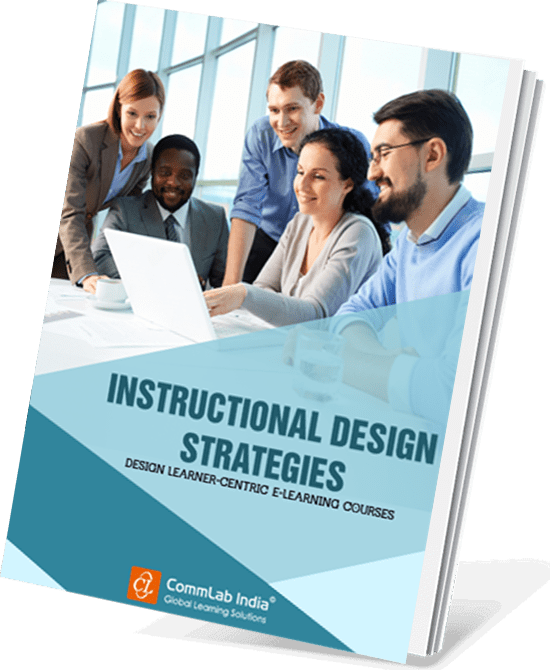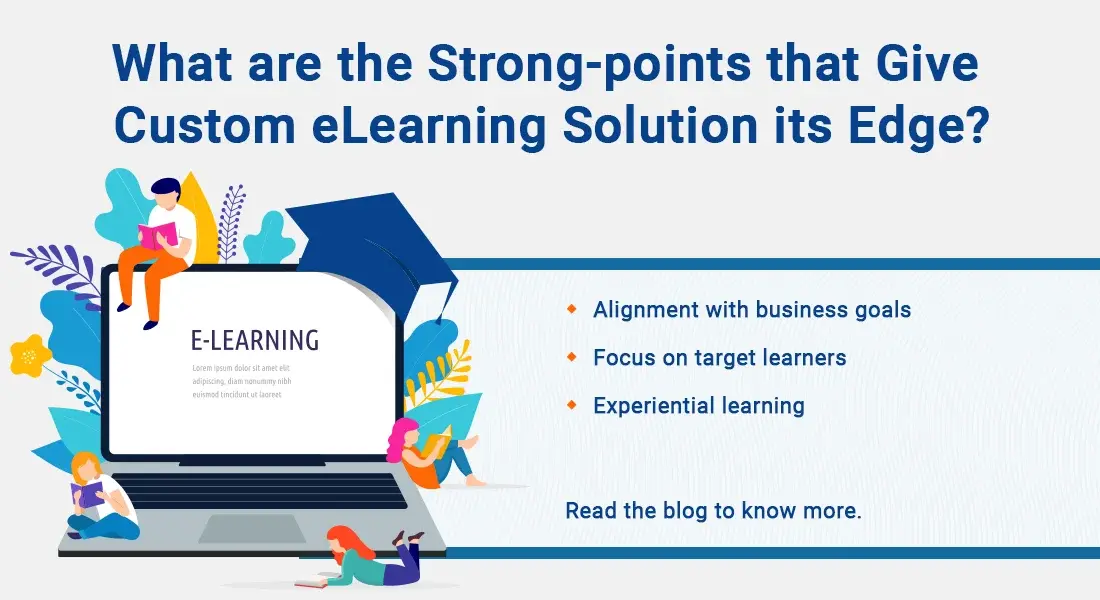What Goes into Creating Award-Winning Custom eLearning Solutions?

In today's rapidly evolving digital landscape, eLearning has transcended its role as a mere trend to become an indispensable tool for organizations seeking to upskill their workforce. The convenience and effectiveness of eLearning make it a cornerstone of modern corporate training strategies. However, not all eLearning solutions are created equal. The difference between a mediocre course and an award-winning one often lies in the approach to design and development. Instructional designers who specialize in creating custom eLearning solutions have a unique opportunity to craft experiences that are not only engaging but also tailored to meet specific organizational goals. In this comprehensive guide we will explore different components that play a major role in the creation of award-winning custom eLearning solutions. Moreover, by reading this blog, instructional designers will also gain valuable insights into how they can push the boundaries of what eLearning can achieve. So without further ado, let’s begin!
→ Download Now: Instructional Design Strategies to Design Engaging eLearning Courses
Table of Contents
- What Is Custom eLearning?
- What Are the Benefits of Custom eLearning Solutions?
- What Goes into Creating Award-Winning Custom eLearning Solutions?
What Is Custom eLearning?
Custom eLearning refers to the process of designing and developing online training courses that are tailored specifically to meet the unique needs, goals, and preferences of an organization and its employees. Unlike off-the-shelf eLearning solutions, which are generic and designed to cater to a broad audience, custom eLearning is highly personalized. It takes into account the specific challenges, learning objectives, and learning styles of the target audience, as well as the organizational culture and branding.
The custom eLearning development process typically involves close collaboration between instructional designers, subject matter experts (SMEs), and stakeholders within the organization. This collaboration helps ensure that the training content is not only accurate and relevant but also aligned with the company's values, policies, procedures, and business objectives.
Custom eLearning can be used to cover a wide range of topics in corporate training. These include:
- Onboarding training
- Product training
- Technical training
- Sales enablement
- Compliance training
- Leadership training
- Sustainability training
In essence, custom eLearning solutions are all about creating a learning experience that is unique to the organization and its employees. By focusing on the specific needs and goals of the learners, custom eLearning solutions are more likely to achieve the desired outcomes and provide a greater return on investment (ROI) compared to one-size-fits-all off-the-shelf eLearning courses.

Instructional Design Strategies to Design Engaging eLearning Courses
Design Learner-Centric eLearning
- Importance of ID Strategies in eLearning
- Parameters to Select the Right ID Strategy
- ID Strategies for Effective Results
- Case Studies
What Are the Benefits of Custom eLearning Solutions?
Custom eLearning solutions offer a wide array of benefits that make them an attractive option for organizations looking to enhance their corporate training programs. These benefits are particularly helpful for companies that have unique and diverse training needs. Some of the key advantages of custom eLearning in corporate training are given below.

Now let’s explore each benefit in detail.
Tailored Content
With the help of custom eLearning solutions, organizations can create training content that is specifically tailored to their needs. This means that the course material is directly relevant to the learners, making it easier for them to relate to and apply the knowledge in their day-to-day work. Furthermore, tailored content can address specific business challenges, reinforce organizational values, and support strategic goals. It ensures that the training is aligned with the overall direction and goals of the company.
Enhanced Learner Engagement
I’m sure you’d agree when I say that one of the biggest challenges in eLearning is keeping learners engaged. Isn’t it? But not anymore. With custom eLearning solutions, organizations can incorporate interactive elements, real-world scenarios, and multimedia components in their training courses to keep their learners attentive and engaged throughout the learning process.

Moreover, by curating content that resonates with the target audience, organizations can see a significant improvement in learner engagement. To level-up the curation factor, organizations can also use relatable examples and personalized scenarios. It creates a more immersive learning experience that captures learners' attention and keeps them motivated.
Improves Knowledge Retention Rates
Because custom eLearning is designed with the specific needs of the learners in mind, it is more likely to result in effective knowledge transfer and skill development. The content is not only relevant but also structured in a way that supports the learners' progress toward the desired outcomes. This targeted approach in custom eLearning solutions helps learners to better understand and retain the information, leading to improved performance on the job.
Ensures Brand Consistency
While off-the-shelf eLearning courses might seem like an easy option for corporate training but custom eLearning’s option to integrate company’s branding, culture, and values into the training material is a clear winner in terms of efficiency and impact. The consistency in training material reinforces the organization's identity in the minds of learners and helps to build a strong, cohesive company culture. Whether it's through the use of company colors, logos, or language, custom eLearning can ensure that the training experience feels like an integral part of the organization, rather than an external add-on.
Enables Flexibility
One of the defining characteristics of custom eLearning is its flexibility. Instructional designers can choose from a variety of formats and media, such as interactive simulations, video tutorials, gamified modules, and scenario-based learning, to create an engaging and effective learning experience. This flexibility allows custom eLearning solutions to be highly adaptive, catering to different learning preferences and ensuring that the content resonates with all learners.
Supports Scalability
Custom eLearning solutions can be easily scaled and adapted to meet the changing needs of the organization. Whether an organization needs to roll out training to a large, dispersed workforce or update content to reflect new regulations, custom eLearning provides the flexibility to make these changes quickly and efficiently. Along with this, the integration of AI tools significantly enhances this scalability, making the process even more efficient and effective. Instructional designers can leverage AI tools for various tasks involved in the custom eLearning development. For example, they can create high-quality videos with the help of AI tools with minimal effort and time.
Cost-Effectiveness
While the initial investment in custom eLearning may be higher than purchasing off-the-shelf courses, the long-term benefits often outweigh the costs. Custom eLearning reduces the need for additional training by addressing the specific needs of the learners from the outset. It can also save time and resources by streamlining the training process and reducing the need for repetitive or redundant content.
Data-Driven Insights
Custom eLearning solutions include access to learning analytics and reporting features that offer valuable insights into learner performance and engagement. These data-driven insights allow organizations to measure the effectiveness of their training programs, identify areas for improvement, and make informed decisions about future training initiatives. By continuously monitoring and refining the eLearning content, organizations can ensure that their training programs are always optimized for maximum impact.

Instructional Design Strategies to Design Engaging eLearning Courses
Design Learner-Centric eLearning
- Importance of ID Strategies in eLearning
- Parameters to Select the Right ID Strategy
- ID Strategies for Effective Results
- Case Studies
What Goes into Creating Award-Winning Custom eLearning Solutions?
At the heart of every successful custom eLearning solution lies a solid instructional design foundation. This foundation is the bedrock upon which all other elements are built. It’s important to remember that instructional design is not just about content delivery; it’s about creating a structured learning experience that leads to measurable outcomes. For instructional designers, this involves a thorough, well-planned process.
Want To Create Impactful, Unforgettable Custom eLearning Solutions?
Here are the 10 things to remember.
- Conducting Training Needs Analysis
- Creating Relevant Learning Objectives
- Choosing the Right Instructional Design Strategies
- Leveraging the Right Technology
- Incorporating Interactive Elements
- Maximizing Learner Engagement
- Personalizing the Learning Experience
- Creating Relevant Assessments
- Thorough Evaluation and Refinement Process
- Keeping Up with Industry Trends
Continue reading to know about each aspect in detail.
1. Conducting Training Needs Analysis
In the journey of crafting a custom eLearning solution, understanding your learner through training needs analysis is the first step. This step helps identify the specific learning gaps and objectives that the course must address. Conducting a training needs analysis (TNA) involves gathering information about the target audience. This includes their current knowledge levels, educational background, skills, and learning preferences. By understanding who the learners are and what they need to achieve, instructional designers can create training courses that resonate with them in an effective manner.
For example, if the target audience consists of sales professionals, the training needs analysis might reveal that they require training on advanced negotiation techniques. In this case, the instructional design would focus on scenarios and role-plays that simulate real-world negotiation situations, allowing learners to practice and refine their skills.
2. Creating Relevant Learning Objectives
Once the training needs have been identified, the next step is to establish clear and measurable learning objectives. These learning objectives serve as the roadmap for the entire custom eLearning experience and guide the design and development of training content and eLearning assessments. Therefore, it’s important to set SMART learning objectives.

For instance, if the goal is to improve customer service skills, learning objectives might include developing effective communication skills, resolving customer complaints with empathy and efficiency, etc. Having well-defined learning objectives in place provides a clear direction for both the instructional designer and the learner, ensuring that the custom eLearning course delivers tangible results.
3. Choosing the Right Instructional Design Strategies
Instructional design strategies are an integral factor in the effectiveness of custom eLearning solutions. Different strategies can be employed depending on the nature of the corporate training, the characteristics of the learners, and the desired outcomes. Finding the right one makes or breaks the impact of the entire training program.
Here are some popular instructional design strategies that can elevate a custom eLearning course to award-winning status:
- Simulations: Simulations are a fantastic way to create realistic, engaging learning experiences. They give learners the chance to try out their knowledge in a safe, supportive setting. For instance, a healthcare organization might use simulations to train nurses in emergency procedures, giving them the opportunity to practice life-saving techniques without worrying about harming patients.
- Gamification: Incorporating game-based elements into custom eLearning programs can significantly increase engagement and motivation. Gamification techniques such as points, badges, and leaderboards can create a sense of competition and achievement, encouraging learners to complete the course and perform well. For example, a sales training program might use a leaderboard to track top performers, which can be a great motivator for others to improve their sales techniques.
- Microlearning: Microlearning is an effective strategy to make learning more manageable for those with limited attention spans or who need just-in-time training. It's all about breaking down content into smaller, more digestible modules. This approach allows learners to focus on one concept or skill at a time, making it easier to absorb information and apply it right away in their work.

Instructional Design Strategies to Design Engaging eLearning Courses
Design Learner-Centric eLearning
- Importance of ID Strategies in eLearning
- Parameters to Select the Right ID Strategy
- ID Strategies for Effective Results
- Case Studies
4. Leveraging the Right Technology
In today’s tech-driven world, it’s no wonder that technology is the powerhouse behind modern custom eLearning solutions. Whether it’s an eLearning authoring tool or an AI tool for creating videos, technology enables the creation of interactive, multimedia-rich personalized content that can be accessed anytime, anywhere. So needless to say, instructional designers must be adept at leveraging the latest tools and technologies to deliver engaging and effective custom eLearning experiences.
Choosing the right eLearning authoring tool for custom eLearning solutions is a critical decision in the eLearning design and development process. eLearning authoring tools are software platforms that allow instructional designers to create custom eLearning content. When it comes to selecting the right custom eLearning authoring tool, it depends on a variety of factors. These include:
- Complexity of the training material
- Desired level of interactivity
- Technical capabilities of the design team
Check out the infographic below to know a few examples of eLearning authoring tools.

These tools support the integration of multimedia elements such as videos, animations, audio, interactive quizzes, etc., into custom eLearning courses. This enhances learner engagement and knowledge retention rates. Additionally, many eLearning authoring tools offer responsive design capabilities which ensure that the custom eLearning content is accessible on various devices like laptops, computers, and smartphones.
5. Incorporating Interactive Elements
Interactive elements are essential for creating an engaging eLearning experience. They encourage active participation, which is key to effective learning. Wondering which type of interactive elements can be included in the custom eLearning courses? Let's take a look.

Now it's time to dig deeper into each type of interactive element.
eLearning Interactivities: To make the custom eLearning courses interactive and engaging, it’s important to provide the learners with opportunities where they can interact with the training content. eLearning interactivities stand tall when it comes to incorporating such opportunities. They allow learners to perform some sort of action in the learning process which boosts active learning and tackles passive learning effectively.

Quizzes and eLearning Assessments: Quizzes and eLearning assessments are an effective method for reinforcing concepts and evaluating the learner's comprehension of the information conveyed. Interactive quizzes can include multiple-choice questions, drag-and-drop activities, and matching exercises. Providing immediate feedback on quiz results enables learners to identify areas requiring improvement.
Branching Scenarios: Branching scenarios offer learners the opportunity to make decisions along the learning process and each decision affects the final outcome of the course. This type of interactivity is particularly effective where organizations want to train the employees in decision-making skills. One area where decision making plays a vital role is leadership. Leveraging branching scenarios as an interactivity in custom eLearning allows learners to explore the consequences of their decisions in a risk-free environment.
6. Maximizing Learner Engagement
Learner engagement is a crucial factor in the success of any eLearning solution. Engaged learners are more likely to retain information, apply what they've learned, and complete the course. Therefore, to create award-winning eLearning experiences, instructional designers must prioritize engagement by making the content relevant, interactive, and enjoyable. Here are a few ways to do so:
- Multimedia Elements: Integrate videos, animations, images, audio, etc. into the custom eLearning courses enhances learner engagement and overall learning experience.
- Storytelling: Using narratives makes the training content more relatable and memorable for learners.
- Gamification: Use points, badges, ranks, levels, leaderboards, etc., to foster participation among learners.
- Microlearning: This comes in handy for not overwhelming the learners with too much information. Breaking down the information into short, digestible modules makes the learning process easy, effective, and engaging.
- Time-Restricted Challenges: Including timed activities creates a sense of urgency among the learners leading to better focus and active engagement.
- Real-World Scenarios: Adult learners tend to be more interested in information that holds real-life value and benefits. So try including practical examples that learners can relate to.
- Social Learning and Collaboration: Facilitating collaboration and interaction among learners boosts engagement levels. Here’s an infographic highlighting tips to use social learning for effective online training.

7. Personalizing the Learning Experience
Custom eLearning solutions should focus on adaptive learning for maximum impact and efficiency. For those who are wondering what adaptive learning is, it is a technology-driven approach that personalizes the learning experience based on the learner's performance and preferences. By analyzing data on how learners interact with the course, adaptive learning systems adjust the type of content presented to the learner, its pace, and level of difficulty to suit each individual's needs.
Let’s say, if a learner struggles with a particular concept, the personalized path approach will focus on providing additional resources or practice exercises to help them master the topic. On the contrary, if a learner demonstrates proficiency in a certain area, the adaptive learning system might skip over certain content or present the learner with more challenging information to keep them attentive and engaged. Adaptive learning ensures that each learner receives the support he or she needs to be successful, resulting in better outcomes and higher training ROI.
8. Creating Relevant Assessments
Creating relevant assessments is key to measuring the effectiveness of a custom eLearning solution. These eLearning assessments should be directly aligned with the learning objectives and designed to evaluate the specific skills and knowledge that the course aims to develop. By designing assessments that reflect real-world applications and challenges, instructional designers enable training managers and instructors to gauge how well learners are able to transfer what they've learned to their jobs. Relevant assessments are not only valuable for understanding the progress of the learner and providing them proper, constructive feedback, but also prove beneficial for L&D teams in analyzing the effectiveness of the training, guiding future improvements.
Here are two common types of eLearning assessments.
.png?width=1920&height=1080&name=2%20Common%20Types%20of%20Assessment%20(2).png)
Let's take a detailed look at each assessment type.
Formative Assessment for Monitoring Progress
Formative assessments are conducted throughout the custom eLearning course to monitor learner progress and identify areas for improvement. These assessments can take the form of quizzes, surveys, one-word answers, fill-in-the-blanks, or assignments that provide immediate feedback to both learners and the instructor.
For example, in a custom eLearning course designed to build leadership skills, formative assessments might include scenario-based quizzes where potential leaders must choose the best course of action in a given situation. The results of these assessments can help trainers identify which concepts are well-understood by the learners and which require further reinforcement. This ongoing evaluation allows for real-time adjustments to the content and instructional methods, ensuring that learners are on track to meet the course objectives.
Summative Assessment for Measuring Outcomes
Summative assessments are conducted at the end of the custom eLearning course. It focuses on evaluating overall learning outcomes. This kind of assessment method is more comprehensive and is used to determine whether the learners have achieved the desired learning objectives or not.
Summative assessments might include:
- Final exams
- Group projects
- Essays
- Assignments
- Simulation-based exams
All these methods require learners to apply their overall knowledge and skills in a practical context instead of just aiming at a single topic or concept.
For instance, in a customer service training program, the summative assessment could involve a role-playing exercise where learners must handle a series of challenging customer interactions. The assessment would evaluate their ability to use the techniques and strategies covered in the course, providing a clear measure of the training’s effectiveness.
Summative assessments not only help evaluate learner performance, but also provide insight into the overall effectiveness of the course. If a significant number of learners are struggling with certain aspects of the summative assessment, this may indicate a need to review and improve those sections of the custom eLearning material.
9. Thorough Evaluation and Refinement Process
Creating an award-winning custom eLearning solution is not a one-time effort. It requires continuous evaluation and refinement to ensure that the course remains effective and relevant over time. For this, it’s important that the instructional designers pay close attention to the assessment process, analyze data, gather learner feedback, and make necessary adjustments to the training content in order to optimize the learning experience for employees.
Check out the infographic below to ensure you gain the right feedback.
Instructional designers can use the feedback garnered through these questions to make targeted enhancements, such as clarifying complex concepts, adding more interactive elements, or updating content to reflect the latest industry trends.
Additionally, data analytics can work wonders when it comes to the process of continuously improving the custom eLearning courses. By analyzing learner performance data, training managers can identify patterns that indicate areas for improvement and coordinate with instructional designers to make improvements in the course.
For example, if analytics reveal that a significant portion of learners is dropping out after a particular module, it may suggest that the module is too difficult, too long, or not engaging enough. With the help of this information, instructional designers can make necessary changes to optimize the learning experience.
10. Keeping Up with Industry Trends
The eLearning field is continuously evolving! New technologies, methodologies, and insights see the light of the day but fade quickly. To maintain the award-winning level of the custom eLearning solutions, it’s essential for organizations to stay informed about the latest trends and best practices in the industry. Staying ahead of the curve enables instructional designers to deliver high-quality, relevant training material to the learners in a way that is effective and yields desired results. Moreover, being proactive in keeping up with the changes in industry trends and information helps IDs in incorporating the relevant information into their courses as well.
For example, the rise of artificial intelligence (AI) in eLearning has opened up new possibilities for personalized learning experiences. By integrating AI-driven tools, instructional designers can create courses that adapt to individual learners’ needs, providing customized content, recommendations, and support. Similarly, advancements in virtual reality (VR) and augmented reality (AR) are enabling more immersive learning experiences, particularly in fields where hands-on practice is critical, such as medical training or technical skills development.
To stay updated on the industry trends, you can:
- Attend industry conferences
- Attend webinars
- Engage with professional communities
By continuously learning and adapting, L&D professionals can ensure that their custom eLearning solutions remain cutting-edge and effective.
Watch this video to explore the various upcoming trends in custom eLearning solutions.
Concluding Remarks!
The goal of any custom eLearning solution is to empower learners to achieve their full potential and contribute meaningfully to their organizations. However, creating award-winning custom eLearning solutions is a complex, multifaceted endeavor that requires a deep understanding of instructional design, technology, learner engagement, and continuous improvement. For instructional designers, the challenge lies not only in crafting content that is informative and engaging but also in ensuring that the learning experience is personalized, accessible, and aligned with organizational goals. The role of instructional design strategies in creating high-quality, effective custom eLearning solutions cannot be emphasized enough. So make sure you get your basics right! Need some help with that? Here’s a comprehensive eBook on instructional design strategies that will guide you in creating engaging, award-winning custom eLearning solutions. Download now!


![6 Questions to Get the Right Feedback on Training [Infographic] 6 Questions to Get the Right Feedback on Training [Infographic]](https://blog.commlabindia.com/hs-fs/hubfs/Imported_Blog_Media/6-questions-to-get-right-feedback-on-online-training-infographic1.png?width=892&height=2112&name=6-questions-to-get-right-feedback-on-online-training-infographic1.png)



